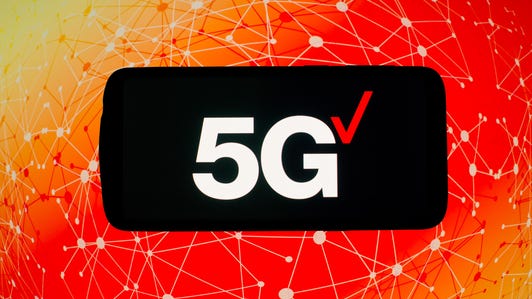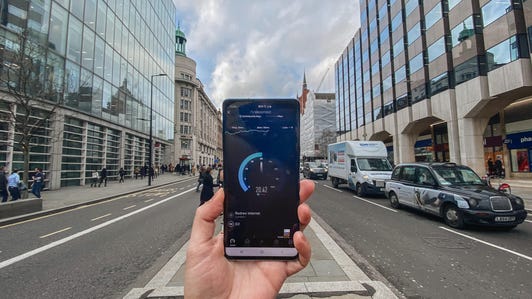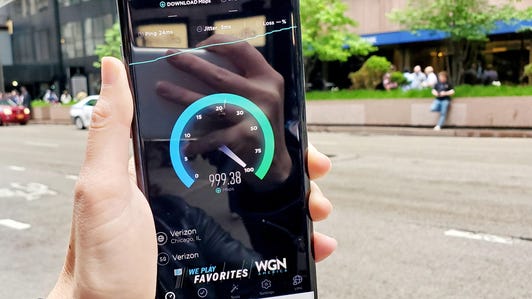The next generation of high-speed mobile data, known as 5G, is live in many countries including the US, the UK and Australia. But as the new network rolls out, many misconceptions and confusion around the technology remain. One of the most alarming falsehoods sprang up in the midst of the coronavirus pandemic, when conspiracy theorists back in May tried linking 5G with the spread of the virus itself. This resulted in people burning cell towers and threatening broadband engineers. Many social media platforms at the time, including Twitter, YouTube and Facebook scrambled to curb the spread of this misinformation.
This isn’t completely surprising — 5G will have an impact on many people’s lives all around the world, and understandably there are a lot of questions being asked. Not only will these 5G networks connect us to a super-fast mobile network, but entire industries will benefit from the faster connection as well, including the healthcare industry, self-driving cars, drones and the Internet of Things. As the 5G rollout continues throughout 2020, it’s predicted that there will be 1 billion 5G customers by 2023.
To learn more about 5G, we’re debunking a few 5G myths. And if you want to know more about 5G in general, read our FAQ: Everything you need to know about the 5G revolution.


Now playing:
Watch this:
5G means more than just fast downloads to your phone
4:09
Is 5G safe?
One of the biggest concerns about 5G is that the network’s radio frequency will be unsafe, expose people to radiation and cause cancer. The fears aren’t completely unfounded — a 2011 report from the World Health Organization suggested that cellphone radiation should be listed as “possibly carcinogenic to humans.” In 2016, a study funded by the US government showed a link between radio frequency radiation and cancers in rats. And popular phones like the iPhone and Galaxy handsets may exceed the level of radio frequency radiation allowed by the FCC.
But a direct link between cancer and cell phone radiation is complicated and may be overstated. For one thing, a number of things that we encounter every day are considered to be carcinogenic hazards to some degree, including diesel fuel, aloe vera and pickled food. The aforementioned 2016 study also exposed male rats to levels of radiation that exceeded radiation levels that humans would come across from their cellphones.
Though it’s too early to be 100% confident, we do know that in August 2019, after more than six years of research and review, FCC Chairman Ajit Pai circulated a proposal to deem cellphones, including ones that use 5G, as safe. More recently, an Oregon State University study published on July 9 found that the effects of 5G radiation on zebrafish (which react similar to human cells) were benign.
5G, phones and your health
- Is 5G making you sick? Probably note
- Smartphones may be leaking more radiation than we think
- Cellphones and cancer: 9 things you should know right now
Is 5G linked to COVID-19?
With the unprecedented outbreak of the novel coronavirus, many conspiracy theorists posited the idea that 5G is the cause of the virus. In addition, one Facebook user reported that Microsoft co-founder Bill Gates created 5G to decrease the world’s population.
These claims have no scientific merit. According to scientists, health experts and doctors, the new coronavirus is the virus that causes the COVID-19 disease, and is spread through person-to-person contact. There is also growing evidence that the disease can persist and spread through small, airborne particles. In either case, COVID-19 does not spread through 5G networks or radio waves.
Related: Coronavirus explained: Symptoms, lockdowns and all your COVID-19 questions answered.
Will 5G replace 4G? Will I need a new phone?
While you will need a 5G phone to access a 5G network, it doesn’t mean you need one to reap some of its speed benefits. As the new network rolls out, you may experience faster speeds on 4G as well (more on that below). In addition, 5G is not replacing 4G altogether. Rather, it’s its own distinct technology that builds on top of existing 4G networks. So even if 5G is available in your area, your phone isn’t obsolete just yet, and it will still work perfectly fine on 4G.
Related: No, 5G isn’t going to make your 4G LTE phone obsolete.
But will my current phone be faster?
According to a February 2019 GSMA Intelligence report, 15% of global mobile connections will be on 5G by 2025. By that same year, 4G LTE usage will be about 59% — an increase from 43% in 2018. In short, 5G will not replace LTE in the way that 4G did with 3G when it launched. And while the COVID-19 has halted some economies and industries, 5G integration is still rolling out. Shoppers in China, where the outbreak started, consider 5G a must-have and subscriptions to the network are increasing.
Taking that into consideration, those with 4G phones may see a boost in speed as 5G networks roll out. This is due to two reasons: dynamic spectrum sharing and carrier aggregation. DSS technology allows carriers to employ the same spectrum band for 4G and 5G. As people transition to 5G, “lanes” for 4G will be kept open for smart home devices and users who aren’t on 5G yet. As more people leave 4G, its capacity increases and so will speeds. DSS is already helping providers like AT&T and Verizon offer different “flavors” of 5G. In April T-Mobile acquired a large portion of midband spectrum from Sprint after its merger.
Carrier aggregation allows carriers to combine 4G signals with other 4G signals, which will result in “a huge performance and capacity lift,” according to Verizon’s vice president of technology, Heidi Hemmer. And as mentioned before, 5G builds on 4G technology, so you’ll experience lower latency periods (aka: the time between when your phone pings the network and when it responds) as carriers continue to develop their 5G networks.
From Apple to Samsung: 5G phones available right now






+13 more
Will 5G force me into an unlimited data plan?
Depending on the carrier the answer is most likely yes, for now. In the US, Verizon has four unlimited plans and three of them include 5G for an extra $10 a month on top of the regular plans. Three of AT&T’s unlimited plans include 5G and cost $35, $40 and $50 a month for four lines. T-Mobile, which merged with Sprint, is an exception in the US. Its 5G service will be unlimited and won’t cost more than its existing 4G plans.
In general, 5G plans will cost more but don’t expect carriers to be completely clear and transparent about it. As CNET Executive Editor Roger Cheng reported, “LTE didn’t cost any more when it first came out; you just needed to buy a new phone. But pricing models do change over time. Since 4G launched, carriers both took away unlimited plans and brought them back.”


Make sure your streaming plan includes HD video.
Angela Lang/CNET
Will 5G allow me to stream the best-quality video at all times?
Not necessarily, as this depends on your video streaming service provider and your plan. Netflix, for example, has a Basic Plan that only lets you stream videos in standard definition. There is a more expensive Premium Plan, where you can watch high-definition and ultra high-definition videos when available. And while most devices support Hulu’s HD programming, its 4K Ultra HD content is currently only available for some content and on some devices including Apple TV (fifth generation or later), Chromecast Ultra, Fire TV and Fire TV Stick, Xbox One and more. Disney Plus, however, gives all subscribers access to 4K and HDR high-quality video.
Will 5G really allow for remote surgeries and autonomous vehicles?
Back at MWC 2019 in February, CNET Senior Reporter Shara Tibken witnessed what was billed as the first live surgery over 5G that involved a doctor consulting the surgeon from another location. The doctor was able to relay instructions and draw on a video of the patient in real time, as surgeons were performing the procedure.
While entire surgeries performed over 5G isn’t going to be possible right away, there is little doubt that 5G will revolutionize the health care industry. Surgeries performed in remote areas with a doctor located in a different location will be possible over 5G since the network can handle the high bandwidth, quick responsiveness and low latency required to carry out such an endeavor.


Now playing:
Watch this:
5G lets you remotely perform surgery with a robot arm
1:08
With the outbreak of COVID-19 and social distancing policies, an even bigger need for faster internet connection has become more apparent in remote health care and telehealth. High-definition streams and sophisticated imaging of patients can bring health experts into the home, and emergency responders can get immediate mapping and terrain information when they are out in the field (say, a firefighter receiving the schematics of a burning building in real time on an AR headset).
As for autonomous cars, that won’t likely come around for many years, if at all. But 5G is seen as “an enabler” and an “accelerator” for self-driving cars when it comes to communication, latency and bandwidth, according to Dmitri Dolgov, chief technology officer at Google’s Waymo self-driving car business, in a May 2019 interview with VentureBeat.
In addition, CNET Senior Editor Stephen Shankland reported that “C-V2X, a communications technology using the same 5G networks coming to our phones, will allow vehicles to communicate wirelessly with each other, with traffic signals and with other roadside gear, improving both functionality and safety. ”
More on 5G and autonomous cars
- Why 5G for smartphones is just the start
- 5G is still a little magic, a little smoke and mirrors
- 5G could make self-driving cars smarter and commutes safer
Will 5G really close the digital divide?
Not exactly. While the US is continuing to roll out its 5G network, the switchover from 4G to 5G will be staggered. That means that while some pockets will have 5G initially, many larger areas will still be on 4G for a while. There are also many agricultural and rural areas in this country that still don’t have internet, let alone high-speed internet or mobile data. This upcoming 5G era may actually widen the gap even further and the effects of the digital divide is especially evident during the current COVID-19 outbreak.
5G in rural areas
- In farm country, forget broadband. You might not have internet at all
- Why 5G is out of reach for more people than you think
- Life in the slow lane: Welcome to the internet in rural America
- Why rural areas can’t catch a break on speedy broadband
- 5G pipe dream: Millions of Americans lack broadband still
What 5G can do for you besides fast phone downloads






+19 more



